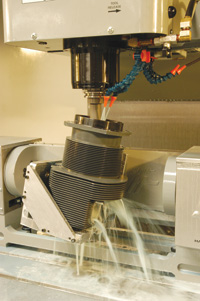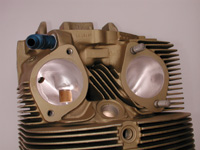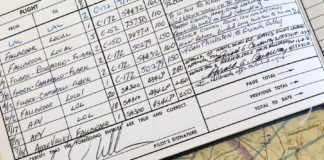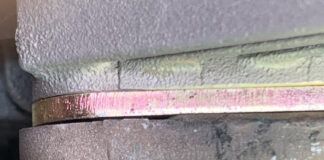Porting cylinder heads sounds like pure hot rodding, and it can be, but the reality is that a large number of certified and non-certified engines have cylinder heads ported by hand. As Ken Tunnell, the main man at engine specialist Ly-Con notes, nine out of 10 engines passing through his shop receive ported cylinder heads. It’s a valuable part of the engine blueprinting that goes into the detailed builds and overhauls that boutique builders such as Ly-Con provide.

What is porting? It’s the massaging of the air passages (ports) leading to the intake and exhaust valves that are cast into the cylinder heads at the factory. These passages are admittedly short sections of the engines total air path, which runs from air filter to exhaust outlet, but the ports and especially the environment immediately surrounding the valve seats and valves are critical in defining how efficiently the engine breathes. Better understood now in the age of computer modeling and sophisticated observational techniques, minor changes in shape, volume and surface texture of the ports can fundamentally improve engine efficiency.
Hand Porting
Traditionally porting is done by hand using a high-speed rotary motor-your basic die grinder-fitted with a variety of carbide-tipped cutters and sanding rolls. The technician skillfully reshapes, resizes and retextures the ports while the cylinders are disassembled. It’s tedious, dirty work.
The trick, of course, is arriving at the optimal shape, size and texture. This is a trial and error process, something Ly-Con went through decades ago when it started hand-porting aircraft cylinders. Cylinders are ported using a calibrated vacuum cleaner/air pump called a flow bench to check progress. Follow-up dyno testing is also required, as what looks good on the flow bench does not necessarily translate into progress in the finished engine. Once a shop has arrived at a proven port design, it can recreate it endlessly for the same basic engine and cylinder head combination as a validated performance enhancer. Clearly this requires an experienced, skilled head porter on staff.
Let’s also note the porting detailed in this article is relatively mild. On certified engines porting involves buzzing off of casting flash, smoothing all surfaces of casting roughness (the pebbly grain left by casting) and the minor reshaping of transitional areas where the air must make sharp turns. In other words, the port cast by Continental or Lycoming is cleaned and adjusted, but not redesigned.
On more hot rod Experimental engines a general reshaping of the port may be accomplished. On the most radical custom jobs-rare and expensive custom work reserved for pylon racers and air show performers-the port may be completely reshaped and relocated by welding up some of the port and redesigning it with the die grinder.
CNC Porting
A recent porting improvement is turning the grinding over to a CNC robot. Such computer numerically controlled machining offers several porting advantages, but the main ideas are the CNC machine is extremely accurate, able to replicate the same port every time, precisely place the port relative to the valve no matter how variable the cylinder casting and via it’s accuracy and repeatability can generate textures a human cannot.
Thanks to its accuracy and surface texture, a CNC ported cylinder head slightly outperforms the same level of hand porting, according to Ly-Con. The improvement is mainly in the intake port, where the CNC machine leaves a series of visible steps that act like golf-ball dimples, breaking and bending the boundary layer more sharply than the smoother texture of hand porting.
On the exhaust side, Ly-Con polishes the CNC-generated steps out because they give exhaust residue a perfect toehold. Thus, the reduction in carbon buildup trumps the airflow improvement from the steps.
About the only disadvantage to CNC porting is extra cost. It takes a machine capable of cutting in at least four axes, and it’s better to have a five-axis CNC machining center to replicate human arm and wrist motion. Such machines represent an investment far in excess of six figures, so the payback has to come from somewhere.
In fact, the high cost of CNC head porting has severely limited its migration from the relatively high-volume hot rod automotive universe to the aviation world. To date Ly-Cons CNC head porting is a general aviation exclusive.
Besides the cash investment, there is the additional time it takes a shop such as Ly-Con to develop the programming to run the CNC machine. Hand porting software develops naturally as the technician practices his craft with no intermediate steps, but building CNC software is best developed using some physical structure that can be digitized.
Ly-Con has handled software development by arriving at the desired port shape via hand porting, then making rubber molds of the idealized ports. These male models are then scanned by a laser to generate a digital file, which is worked into CNC software. It’s proven an accurate method, but it’s fraught with seemingly endless new steps and techniques to master. Like the checks written for the CNC center, the arduous development process needs to be accounted for by the green-eyeshade department.

Ly-Con’s CNC Cylinders
At press time Ly-Con was concentrating solely on it’s bread-and-butter Lycoming 360/540 parallel-valve cylinders for the CNC porting program. Once the parallel Lycomings are up to speed, Ly-Con says it’ll move to 470, 520 and 550 angle-valve Continentals, then angle-valve Lycomings and finally 200 and 300 parallel-valve Continentals. No timetable is in place for the upcoming engines, but the learning curve has been steep for Ly-Con on the CNC machine, so patience is a virtue. That said, once the Ly-Con has a couple of engines noodled out, the remaining applications should come more quickly as Ly-Con has the port shapes developed and needs only to digitize them.
Getting back to the 360/540 parallel cylinders, Ly-Cons general philosophy is to make them no larger in cross sectional area-they’re already slightly too voluminous as cast. The stock cylinder is put in the CNC machine using the valve guides for location and the rocker cover bolt holes as tie-down points. The CNC machine then lightly whittles the entire port, reworks the valve seat-to-port transitions and rationalizes the shape and cross section around the valve guide boss.
From the CNC machine the cylinder is transferred to Ly-Cons Serdi head and seat machine. This is another quality machining center thats dedicated to cutting the valves and valve seats. Compared to the traditional stone-based valve-grinding systems, the Serdi is very accurate. It holds tolerances to 0.0001-inch; stones are good to just 0.0015-inch.
While the Serdi and CNC machines are independent of each other, it’s clear the Serdis accuracy complements the CNCs ability to place the port in precise relationship with the valve seat, maximizing the airflow gains.
Ly-Con is turning 360/540 parallel-valve cylinders out as fast as it can. Pricing is $350 per cylinder for CNC porting. Hand porting is not going away at Ly-Con, either, and that option for the same cylinders is $250 per jug.
What’s It Worth?
Assigning hard and fast performance improvements to port work is difficult at best. So much depends on the combination of parts throughout the engine, plus the dyno doing the measuring; weather even matters. In fact, quoting hard numbers for power improvements is such a minefield that Ly-Con would just as soon pass on the subject.
Still, Ly-Con has some rules of thumb about how much horsepower the porting is worth. Using flow bench and dyno data from experience, shop foreman Bryan Tunnell says, Parallel valve cylinders are improved more than angle valve heads because the parallel cylinders are worse to begin with, so they have more room for improvement.
With hand-porting, the parallel valve jugs make about 5 horsepower more per cylinder than stock. With hand-porting, the angle valve jugs gain about three horsepower per cylinder.
With CNC porting, we don’t know yet for sure how the parallel valve cylinders do, as we don’t have conclusive dyno data on them. But they might pick up an extra horsepower per cylinder.
Assuming a 6 hp/cylinder gain for CNC ported parallel valve 360/540 cylinders, that yields a 24-hp total gain on a 360 and a 36-hp gain on a 540 from the porting alone. Again, these numbers are strictly for guidance; your mileage will vary, as the saying goes.
Furthermore, Ken Tunnell added that from the very first dyno session with CNC-ported cylinders, he’s noted the EGTs are more even cylinder-to-cylinder. This jibes with the CNC and Serdi accuracy that centers every port around every valve guide, regardless of core shift in the parent cylinder casting. With each port/valve/seat relationship identical, each cylinder is bound to flow more consistently compared to it’s neighbors. This should play favorably when leaning the engine in conjunction with an engine analyzer and balanced fuel injectors.
For customers with Experimentals, adding compression with Ly-Cons NFS line of forged domed pistons helps a bit more. Given CNC porting and 10:1 compression, 300- to 310-hp 540s are the current norm before getting into exotic aftermarket induction and exhaust systems. Four-cylinder IO-360 customers can expect about a 30 hp gain with porting and higher compression pistons, the company says.
Best of all, these power improvements are really efficiency improvements. They come from a fundamental betterment of engine breathing, not from turning the engine faster or tuning parameters such as advanced ignition timing or camshaft profile. If increased fuel economy and not horsepower is the major goal, the engine can be run at the original power levels using less fuel (the engine is breathing more easily and uses less fuel to pump air through itself). Translation: faster climbs and more economical cruises. Not bad for a little attention to airflow detail.
For more information, call 559-651-1070, or visit www.lycon.com.













